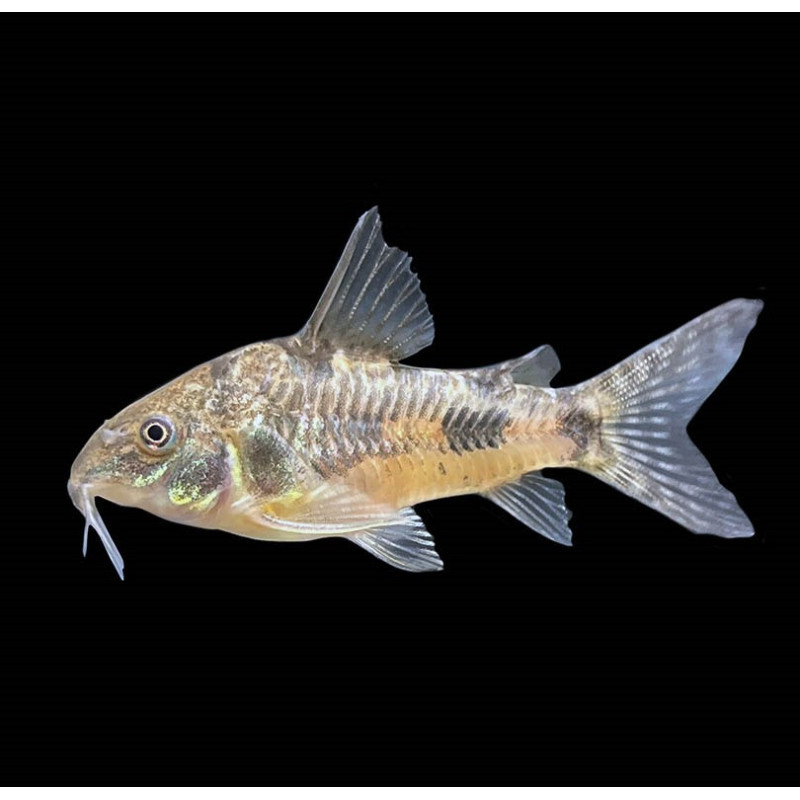Stocks Available
Rabaut's Cory
SKU:125741
Corydoras rabauti
1 INCH

Stock Available
Introduction: • Species: Corydoras paleatus • Common Names: Peppered Cory Catfish, Peppered Cory, Spotted Cory • Natural Habitat: Native to freshwater rivers and streams in South America, particularly in the Paraguay and Paraná River basins, where they thrive in areas with sandy substrates and plenty of vegetation. Physical Characteristics: • Appearance: Characterized by a compact, torpedo-shaped body covered in a mottled pattern of gray and black spots, giving them a peppered appearance. They have a distinctive bony plate structure along their sides. • Size: Typically grows to about 2-3 inches (5-7.5 cm) in length. • Lifespan: Can live for around 5-10 years with proper care. Habitat Requirements: • Tank Size: A minimum of 10 gallons is recommended for a small group; larger tanks are preferable for better swimming space. • Water Conditions: o Temperature: Thrives in water temperatures between 72-78°F (22-26°C). o pH: Prefers slightly acidic to neutral pH levels, around 6.0 to 7.5. • Aquascaping: Provide a soft substrate (like sand) for them to forage, along with plants, driftwood, and hiding spots to mimic their natural environment. Diet: • Primary Diet: Omnivorous; they naturally feed on small invertebrates, plant matter, and detritus. • Supplemental Feeding: Offer high-quality sinking pellets, flakes, and occasional treats of live or frozen foods such as bloodworms or daphnia. • Feeding Frequency: Feed small amounts 1-2 times daily to ensure they receive adequate nutrition without overfeeding. Compatibility: • Temperament: Generally peaceful and social; best kept in groups of at least 4-6 individuals to promote natural behavior. • Suitable Tank Mates: Compatible with other small, peaceful community fish like tetras, rasboras, and guppies. • Incompatibilities: Avoid keeping with aggressive or larger fish that may intimidate or harass them. Care Level: • Difficulty: Easy to moderate; they require stable water conditions and a suitable diet. • Health Monitoring: Regularly check for signs of stress or disease, particularly due to changes in water quality. Breeding: • Breeding in Captivity: Breeding is possible in home aquariums; pairs will form and display courting behaviors. • Spawning: Egg layers; they typically lay eggs on flat surfaces or plant leaves, where both parents may guard them. Economic Considerations: • Market Demand: Popular in the aquarium trade due to their charming appearance and hardiness. • Wholesale/Retail Pricing: Generally affordable, making them accessible to both beginner and experienced aquarists. Sustainability and Conservation: • Wild Population: Generally stable; however, habitat destruction can impact local populations. • Aquaculture Efforts: Often bred in captivity, reducing reliance on wild-caught specimens. • Regulations: Comply with local regulations to ensure sustainable practices in fishkeeping. Conclusion: The Peppered Cory Catfish is a delightful addition to freshwater aquariums, valued for its engaging behavior and beneficial algae-eating habits. With appropriate care and tank conditions, they can thrive, enhancing the diversity and activity of any community aquarium.
Data sheet
6 other products in the same category:
Customers who bought this product also bought: